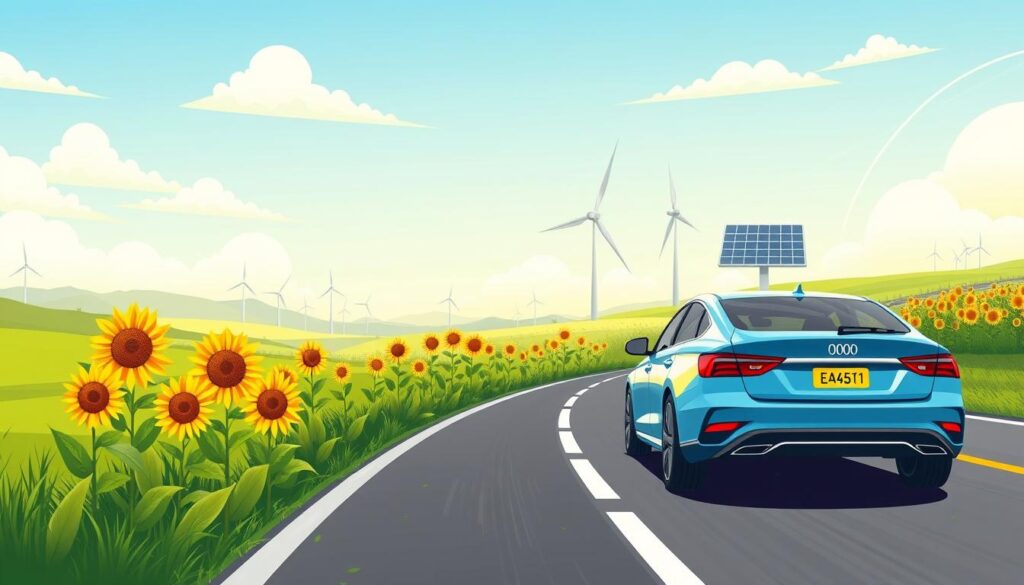In the United States, ethanol has made gasoline cheaper and kept cars running well. It started in 1908 with Henry Ford’s Model T. Since 1980, trillions of miles have been driven on ethanol-blended fuel. Now, almost all U.S. gasoline has 10% ethanol, safe for any car.
Contents
Key Takeaways
- Ethanol-blended fuels have been used in cars for over a century, with the first Model T designed to run on ethanol.
- E10, a blend of 10% ethanol and 90% gasoline, is approved for use in any conventional gasoline-powered vehicle.
- Intermediate ethanol blends like E15, E25, and E30 are approved for use in flexible fuel vehicles (FFVs).
- Blender pumps offer a variety of ethanol fuel blends, giving FFV owners more options to choose from.
- While ethanol has reduced U.S. gasoline consumption, it has also been found to increase carbon dioxide in the atmosphere.
Understanding Ethanol Fuel Blends
Ethanol is a renewable alcohol fuel made from plants. It’s now a big part of the U.S. gasoline supply. Over 98% of U.S. gasoline has ethanol to help clean the air and make the fuel better.
E10: The Standard Gasoline Blend
Most gas has E10, which is 10% ethanol and 90% gasoline. This blend is okay for any car that runs on gasoline. E10 makes engines run better because it has a higher octane level.
E15: The Intermediate Ethanol Blend
E15 is a mix of 10.5% to 15% ethanol and the rest is gasoline. It’s for cars made in 2001 or later. This blend is good for the environment and works well in most cars.
E85: The Flex Fuel Blend
E85 is a mix of 51% to 83% ethanol and the rest is gasoline. It’s for special cars called FFVs that can use E85, gasoline, or both. FFVs let drivers pick the best fuel for their needs.
“Ethanol has a higher octane number than gasoline, providing premium blending properties that can improve engine performance.”
There are different ethanol blends for different cars and drivers. This way, everyone can find a fuel that works for them and helps use more renewable fuels.
Advantages of Using Ethanol-Blended Fuels
Ethanol-blended fuels have many benefits for drivers. They improve fuel performance and are good for the environment. These fuels are becoming more popular in the car industry.
Improved Fuel Performance
Ethanol-blended fuels make cars run better. They add octane to gasoline, which helps prevent engine knocking. This means cars can run more efficiently without using more fuel.
Ethanol also keeps fuel injectors clean. This helps the fuel system work better, making driving smoother.
Environmental Benefits
Ethanol-blended fuels are good for the planet. They burn cleaner than regular gasoline, which means less pollution. If everyone used E-10, we’d use less foreign oil and save over $5 billion a year.
Using ethanol fuels also helps prevent gas lines from freezing in cold weather. This is a big plus for drivers in chilly places.
Overall, ethanol-blended fuels are a great choice for drivers. They offer better performance and are better for the environment. As more people use these fuels, their benefits will grow.

| Advantage | Description |
|---|---|
| Improved Fuel Performance | Ethanol adds octane, reduces engine knocking, and improves fuel system efficiency. |
| Environmental Benefits | Ethanol burns cleaner, reducing emissions and supporting sustainability. |
| Reduced Dependence on Foreign Oil | Widespread use of E-10 could reduce U.S. dependence on foreign oil by over 300 million barrels per year. |
| Economic Impact | Ethanol production supports farmers, creates domestic jobs, and adds billions to the American economy. |
Compatibility of Ethanol Blends with Vehicles
Using ethanol-blended fuels is common, but it’s important to check if your vehicle can handle them. Most cars can run on E10 without issues. But, higher blends like E15 and E85 need careful checking.
E10, with 10% ethanol, is safe for most cars and is the usual fuel type in many places. It’s the most compatible choice for drivers.
E15 is okay for cars made in 2001 or later. It has more ethanol than E10 but still fits many engines well.
For cars made to use more ethanol, E85 is an option. These cars can take up to 85% ethanol. But, E85 is not for regular cars as it can harm the engine and fuel system.
| Fuel Blend | Ethanol Content | Vehicle Compatibility |
|---|---|---|
| E10 | 10% | Suitable for most modern vehicles |
| E15 | 15% | Approved for model year 2001 and newer light-duty conventional vehicles |
| E85 | 85% | Designed for use in flexible fuel vehicles (FFVs) only |
Always check your car’s manual or talk to the maker to pick the right ethanol blend. The right fuel is key for your car’s performance, efficiency, and life.
“Choosing the right ethanol blend for your vehicle is essential for optimal performance and fuel efficiency.”
Can All Cars Safely Use Ethanol-Blended Fuels?
Using ethanol-blended fuels depends on your car’s model year and engine type. The standard E10 blend is okay for most cars. But, E15 and E85 need special care.
Model Year Compatibility
The EPA says E15 is good for cars made in 2001 or later. This covers most cars on U.S. roads. But, it’s not safe for boats, bikes, or small machines like lawnmowers.
Flexible Fuel Vehicles (FFVs)
FFVs can run on up to 85% ethanol. They’re made to use more ethanol than regular cars. This lets drivers pick the best fuel for their needs.
Using ethanol-blended fuels can make your car run better and be kinder to the planet. But, make sure it’s right for your car. Check your car’s manual or talk to the maker to find out what’s best.
| Ethanol Blend | Vehicle Compatibility | Fuel Performance |
|---|---|---|
| E10 (10% ethanol) | All conventional, gasoline-powered vehicles | Improved engine performance and reduced emissions |
| E15 (15% ethanol) | Approved for use in model year 2001 and newer light-duty conventional vehicles | Minimal impact on fuel efficiency compared to E10 or regular gasoline |
| E85 (85% ethanol) | Flexible Fuel Vehicles (FFVs) only | Increased engine performance and reduced greenhouse gas emissions |
Knowing about ethanol-blended fuels helps drivers make smart choices. This can improve their car’s performance and help the planet.

Ethanol’s Impact on Fuel Economy
Studies show that ethanol-blended fuels don’t affect fuel economy much. Using E15 doesn’t change the mileage from the traditional E10 blend. Ethanol actually helps improve efficiency, keeping your vehicle’s performance steady.
Ethanol has about 27% less energy than regular gasoline. But, the blended fuel still performs well. Cars on E10 lose 3-4% in miles per gallon. Those on E15 lose 4-5%, yet they benefit from lower greenhouse gas emissions and a smaller carbon footprint.
For drivers of Flex Fuel Vehicles (FFVs), the effect is more noticeable. They see a 15-27% drop in miles per gallon on E85. Yet, many FFV owners find better torque and horsepower on E85. This suggests some drivers might prefer the extra power over better fuel efficiency.
Source Links
- https://afdc.energy.gov/fuels/ethanol-blends – Alternative Fuels Data Center: Ethanol Blends
- https://news.engin.umich.edu/2020/05/were-doing-ethanol-wrong/ – We’re doing ethanol wrong
- https://afdc.energy.gov/fuels/ethanol-fuel-basics – Alternative Fuels Data Center: Ethanol Fuel Basics
- https://extension.okstate.edu/fact-sheets/ethanol-gasoline-blends-and-small-engines.html – Ethanol Gasoline Blends and Small Engines – Oklahoma State University
- https://www.commerce.nd.gov/community-services/renewable-energy-programs/ethanol-benefits – Ethanol Benefits
- https://fleetpoint.org/fuel/green-fuels/the-pros-and-cons-of-ethanol-fuel/ – The Pros and Cons of Ethanol Fuel – FleetPoint
- https://protecfuel.com/understanding-which-engines-can-use-ethanol/ – Ethanol Compatibility: Understanding Which Engines Can Use Ethanol
- https://www.iea-amf.org/content/fuel_information/ethanol/e10/e10_compatibility – AMF
- https://nebraskacorn.gov/cornstalk/fuel/13-myths-and-facts-about-ethanol/ – 13 Myths and Facts about Ethanol | Nebraska Corn Board
- https://www.nbcphiladelphia.com/news/national-international/what-is-ethanol-and-is-e15-safe-to-use-in-your-car-what-you-need-to-know/3205507/ – Will High-Ethanol Gasoline Ruin Your Car Engine? What to Know About E15
- https://afdc.energy.gov/fuels/ethanol-benefits – Alternative Fuels Data Center: Ethanol Benefits and Considerations
- https://www.fueleconomy.gov/feg/ethanol.shtml – Ethanol
- https://extension.psu.edu/fuel-ethanol-hero-or-villain – Fuel Ethanol: Hero or Villain?

Hi, I’m Sufiyan, the developer behind this platform. I created FuelConsumptionCalculator.com to simplify fuel tracking for everyone — because understanding your vehicle shouldn’t require a degree in mechanics. I’m always working on adding more tools and content to make this site even more useful

